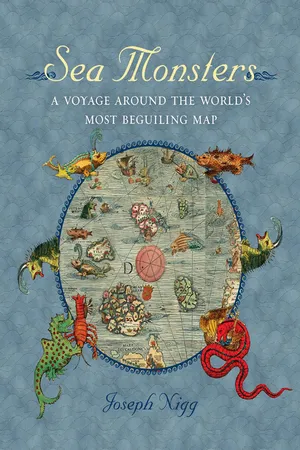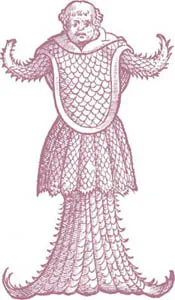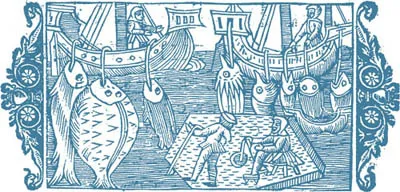![]()
THE VOYAGE
“There are monstrous fish on the Coasts or Sea of Norway”
OLAUS MAGNUS
THE VAST OCEAN
At the outset of a voyage up the northern seas of the Carta Marina, Olaus Magnus speaks of the expanse and mystery of the waters of the world. His paean to the sea and its counterparts to land and sky relies heavily on ancient authority.
“The vast Ocean in its Gulph offers all Nations an admirable spectacle, and shews divers sorts of Fish; and these not onely wonderful for magnitude, as the Stars are compared one with another, as they are terrible in shape; so that there is nothing in the Ayr nor Earth, nor Bowels of it, or in domestique Instruments that may seem to lye hid, that is not found in the depth of the Sea. For in the Ocean that is so broad and by an easie and fruitful increase receives the Seeds of Generation, there are found many monstrous things in sublime Nature, that is always producing something; which being perplexed and rolled up and down one upon another by the ebbing and flowing of the Waters, they seem to generate forms from themselves and from other principles; that whatsoever is bred in any part of nature, we are perswaded is in the Sea, and many things are to be found there that are to be found nowhere else.
And not onely may we understand by sight that there are Images of Animals in the Sea, but a Pitcher, a Sword; Saws and Horses heads apparent in small Shell fish. Moreover you shall find Sponges, Nettles, Stars, Fairies, Kites, Monkies, Cows, Woolves, Mice, Sparrows, Black-Birds, Crows, Frogs, Hogs, Oxen, Rams, Horses, Asses, Dogs, Locusts, Calves, Trees, Wheels, Beetles, Lions, Eagles, Dragons, Swallows and such like: Amongst which, some huge Monsters go on Land and eat the roots of Trees and Plants: Some grow fat with the South wind; some with a North wind blowing.
Also, I must add, that on the Coasts of Norway, most frequently both old and new Monsters are seen, chiefly by reason of the inscrutable depth of the Waters. Moreover, in the deep Sea, there are many kinds of fishes, that seldome or never are seen by men.”
This book’s charted voyage begins at the bottom of the map and winds northward through the vast ocean’s Nordic seas, in whose waters Olaus’s sea beasts endanger fishermen and sailors. Like modern whale-watching tours, this course is set to sail in the map’s areas where certain beasts are known to be.
CHARTED COURSE ON THE CARTA MARINA
——— H ———
——— E ———
The Sea Worm and giant lobster
——— D ———
——— A ———
Southwest, not keyed, The Sea Unicorn
——— D ———
——— E ———
West, not keyed, The Sea Cow
A Rhinoceros-like Monster and giant lobster
——— D ———
——— A ———
——— B ———
Northwest, not keyed, A Sea Creature
Dangerous Fishing
Olaus continues, turning from ancient authority to what he has observed and what he has gleaned from fishermen who risk their lives on the Norwegian Sea:
“The Fishing is said to be dangerous in the Norway Ocean for many Reasons, because men fish in the open Sea very far from Land: When great Tempests arise, the Fisher-men are soon drown’d by the Waves: Where great Sholes of Ice flote, they are dispersed: by the fishing of Whales, and other Monsters they are distracted. Moreover, sometimes they are debilitated in their hands by some monstrous Fish out of the Sea; and if they do not presently let them go a Tempest riseth and drowns them. If therefore some rash Fisher-men, fighting with some Sea Monster, pull him into the ship, that is like a Fryer with his Cowl, they are presently overwhelmed with howling and crying of these Monsters, that they can neither cast forth their Hooks to catch fish nor row with their Oars, and they can scarce hoise [hoist] up Sail to be gone, unless they let go the Monster.
Many Thousands of Fisher-men dwell in the Villages in the utmost Borders of Norway. In February and March, and also in January, the Inhabitants of this Country go in strong ships to fish from the shore into the Deep: as far as they can sail in two days, carrying with them necessaries for their Food for 20 or 30 days. But the place where they most frequently exercise their Fishing is between Norway and Island. Nor do the Fisher-men, when it is Tempestuous Weather, ride at Anchor, but they fish floting up and down till their ships be full. And it is observed that when ever monstrous fish are drawn forth of the Sea; with men or Lions faces, and the like, that this always foreshews Discords and War in the Land.”
A sea monster “like a Fryer with his Cowl.” Conrad Gesner’s Sea Monk, (or Monk-fish), reproduced from Guillaume Rondelet’s book of fishes and adapted in many Renaissance natural histories. During Gesner’s own lifetime, the monster was caught in the Baltic, near Copenhagen. Marine authority Richard Ellis concludes the animal was a giant squid (The Quest for the Giant Squid, 1998). Rondelet, Gesner, and others pair the Sea Monk with the Sea Bishop, another cleric figure, based on a 1531 sighting near Poland.
A vignette from Olaus Magnus’s History chapter. Olaus Magnus scholar John Granlund notes the fish are cod and a halibut and that ice-fishing was not done in the north Norway waters.
Northern Ships
Fishermen and merchants ply the waters of the Carta Marina in crafts of many sizes and kinds: from rowboats, rafts, and leather boats of the Greenlanders to sailing ships of the northern European nations. While ships that decorate the open spaces of maps are often generic, Olaus’s are not. Like the tales he heard from Scandinavian fishermen, his boats and ships derive from his first-hand experience of living in the Baltic port city of Danzig and traveling throughout Scandinavia.
The medieval merchant vessels in the North Sea were influenced by the ships of the Norsemen. Like their predecessors, Hanse cogs—cargo boats of the thirteenth and fourteenth centuries—were also “clinker-built” with overlapping hull planks, with a single square sail. Their side rudder, however, was moved to the stern, under a fighting platform. These were the ships of the Hanseatic League, a federation established by northern German cities to protect their trading interests. While the alliance’s centuries-long dominance of Northern European trade routes was fading, the three-masted carracks of southern Europe transformed shipbuilding in the North. These were typically “carvel-built,” with joined hull planking.
Carta Marina scholar Edward Lyman points out that the model for most of Olaus’s larger ships would seem to be a Flemish form o...



























